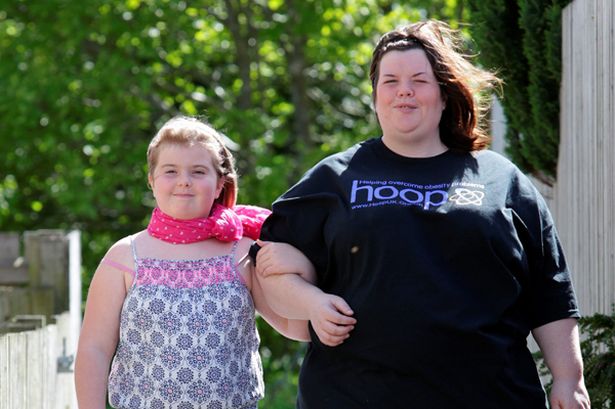Boma Benjy Iwuoha
I spent some part of my last holiday visiting the home of my childhood friend – Aijay, who is a paediatrician and a mother of three. We relived old memories, remembering the “good old – stress-free days”, and our crazy childhood.
While catching up on old times, I mentioned bumping into a mutual friend, Kelly; who had attended the same schools we did. Kelly had always been on the big side, and as we progressed, she got even bigger, by the time we were graduating from the university, she was visibly obese, she, however, never failed to educate anyone who cared enough to listen, that the big set look, runs in her family. Fast forward twenty years on, here she was in a supermarket, with her 7-year old daughter that looks just like she did back in the day. Seeing them reminded me of her mum’s visit, during our boarding school days. Her mum back then, had looked just like our Kelly now does, and I had to ask Aijay; could it really be hereditary?
Aijay in her usual manner smiled and said to me, Bee; read it up. And that’s exactly what I did.
Did you know that Pediatric obesity has been viewed as a growing epidemic of the past few decades that requires intervention, similar to tobacco use? Over the last decade, there have been predictions from medical and health researchers that obesity will surpass tobacco as the biggest threat to overall well-being. A 2016 report by Alaska Department of Health and Social Services stated that obesity already surpasses tobacco in estimates of annual medical costs in Alaska at $459 vs. $318 million. And this is just one of many similar statistics. In a more recent article by Kelly Heyworth the creator of Happy Healthy Kids, she cited a discussion with Dr Ludwig the director of Optimal Weight for Life (OWL) program at Boston Children’s Hospital, where he stated that Obesity has now surpassed tobacco as the biggest threat to overall well-being.
Why I’m I so worried? A January 2018 report, published by the Center for Disease Control and Prevention, stated that in the United States, the percentage of children and adolescents affected by obesity has more than tripled since the 1970s. Data from 2015-2016 show that nearly 1 in 5 school-age children and young people (6 to 19 years) in the United States is obese. This report comes from a region with statistics; now think about regions with much less informatics.
As parents, we often find ourselves trying to manage our kids eating habits without making them feel less beautiful. We also find ourselves on the tricky path of identifying the difference between a child who is at risk for obesity and one who is naturally big boned or muscular. Studies have shown that parents are oftentimes poor judges of their child’s weight even when the problem is seemingly obvious. More so, being overweight has become so common that parents have come to view children having excessive weight as ‘normal’. A recent study published in Childhood Obesity stated that researchers found that more than 96 percent of parents of overweight preschoolers thought that their child was the ‘right’ size. Weight remains an incredibly touchy topic; so it’s little wonder you find a popular retort “Find a new doctor!” among parents who are advised by a paediatrician that their child’s BMI is too high.
Whether a child is overweight, obese, or at the risk of becoming so, it’s key to find a balance between encouraging healthier habits and not making them anxious about their size, because despite how common it is, studies have also shown that it “being fat” is the primary reason most kids are bullied. This may also be one reason why childhood obesity is strongly linked to low self-esteem and depression in adulthood. Oftentimes parents while trying to help their child’s with self-esteem, find themselves using phrases like, “you come from a line of heavy set people – your weight is just right – you are not overweight” etc. This will usually make the kid feel better, but will not tackle the budding weight problem. Fast forward 20 years on, and you have a Kelly, looking like her mum, holding a 7-year-old, who looks just like she did 20 years back. What I’m I saying? Build the child’s self-esteem, but do something about the budding weight issue.
While a few extra pounds do not necessarily suggest obesity, they may indicate a tendency to gain weight easily, and a call for a change in diet/exercise routine may be required. A child is not usually considered obese until the weight is at least 10 percent higher than what is recommended for their height and body type. (Read up BMI) Obesity oftentimes begins between the ages of 5 and 6, or during adolescence. Studies have shown that a child who is obese between the ages of 10 and 13 has an 80 percent chance of becoming an obese adult. Remember, it’s never too early or too late to make a healthy change.
Experts say that the already slippery slope of managing an overweight child becomes even steeper when they approach adolescence, as research has it, 8 out of 10 overweight children will remain so as grown-ups. It is a lot easier to fix a budding weight issue than an established one, so intervening before these kids slide into a long-term problem is crucial is important. Children have a unique advantage over adults: They’re still growing, so they don’t have to lose weight to grow out of a minor problem; they just need to slow their rate of weight gain.
To answer the question, is it really hereditary? There’s no doubt that genetics comes in the list of causes of obesity, however, research shows that Obesity in childhood and adolescence can also be related to: poor eating habits, overeating or binging, lack of exercise (i.e., couch potato kids), family history of obesity, medical illnesses (endocrine, neurological problems), medications (steroids, some psychiatric medications), stressful life events or changes (separations, divorce, moves, deaths, abuse), family and peer problems, low self-esteem, depression or other emotional problems. This invariably means we cannot put the blame entirely on genetics, and even if there are genetic factors involved, there are ways to manage your kid’s weight. Now here are some tips from the Centre for Disease Control and Prevention about what you can do as a parent or Guardian to help prevent childhood overweight and obesity.
Balance the Calories: Help your children develop healthy eating habits – One part of balancing calories is to eat foods that provide adequate nutrition and an appropriate number of calories. You can help children learn to be aware of what they eat by developing healthy eating habits and reducing calorie-rich temptations. Remember, small changes every day can lead to a recipe for success, and look for ways to make their favourite dishes healthier. The recipes that you may prepare regularly, that your family enjoys, with just a few changes can be healthier and just as satisfying.
Remove calorie-rich temptations: Although everything can be enjoyed in moderation, reducing the calorie-rich temptations of high-fat and high-sugar, or salty snacks can also help your children develop healthy eating habits. Instead only allow your children to eat them sometimes so that they truly will be treats!
Help them Stay Active: Another part of balancing calories is to engage in an appropriate amount of physical activity and avoid too much sedentary time. In addition to being fun for children, regular physical activity has many health benefits, including Strengthening bones, decreasing blood pressure, reducing stress and anxiety, increasing self-esteem, and helping with weight management.
Children should participate in at least 60 minutes of moderate-intensity physical activity most days of the week, preferably daily. Remember that children imitate adults. Start adding physical activity to your own daily routine and encourage your child to join you.
Some examples of moderate-intensity physical activity include: Brisk walking, Playing tag, jumping rope, playing soccer, Swimming, Dancing
Reduce sedentary time: In addition to encouraging physical activity, help children avoid too much sedentary time. Although quiet time for reading and homework is fine, limit the time your children watch television, play video games, or surf the web for no more than 2 hours per day. Additionally, the American Academy of Pediatrics (AAP) does not recommend television viewing for children age 2 or younger. Instead, encourage your children to find fun activities to do with family members or on their own that simply involve more activity.
Set time limits for video games, net surfing etc. do what you must but by all means, get your kids off the couch! They’ll thank you for it.





Comments are closed.